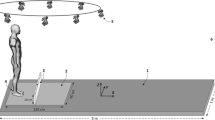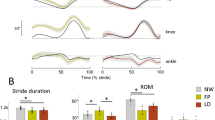Abstract
The aim of this study was to examine the adaptability of the gait initiation process when confronted with stepping on (SO) to a new level. Eight young adults performed gait initiation at two different speed conditions in a level walking (LW) situation and in a SO situation aimed at walking on an elevated (16 cm) level surface. As in a previous study using a single step, we found in SO a contradiction between the characteristics of anticipatory postural adjustments (APA) and gait velocity, i.e. the peak of anteroposterior velocity of the body’s centre of gravity (CG) reached at the end of the first step. In normal and fast gaits, gait velocity was similar in both situations, whereas the duration and amplitude of the APA were smaller in SO than in LW. The reduction of APA in SO allowed the forward velocity of CG at the time of foot contact of the stepping limb to be lower than in LW. This is explained by the fact that the majority of body lift, beginning at this time, required a greater increase in forward velocity than in LW. Thus, with lower APA in SO, the gait velocity could be similar in both situations. From LW to SO, the spatio-temporal patterns in the forward velocity of CG varied within characteristic phases of the movement, but in a predictable way as gait velocity changed. These results gave evidence of an adaptation of the gait initiation process for the new constraints, despite the contradiction between APA and gait velocity. The spatio-temporal parameters of the anticipation phase in SO were pre-set according to the new requirements of the task: reaching gait velocity with a body lift. Furthermore, the time for reaching gait velocity was independent of both the amplitude of this velocity and the situation. This expressed the capacity of the subjects to use in SO the same optimal conditions to reach gait velocity as in LW, i.e. essentially in a ballistic manner.




Similar content being viewed by others
References
Andriacchi TP, Anderson GBJ, Fermier RW, Stern D, Galante JO (1980) A study of lower-limb mechanics during stair climbing. J Bone Joint Surg 62A:749–757
Brenière Y, Bril B (1988) Pourquoi les enfants marchent en tombant alors que les adultes tombent en marchant? C.R. Acad Sci Paris, t.307, Série III, p 617–622
Brenière Y, Do MC (1986) When and how does steady state gait movement induced from upright posture begin? J Biomech 19:1035–1040
Brenière Y, Do MC (1991) Control of gait initiation. J Mot Behav 23:235–240
Brenière Y, Do MC, Sanchez J (1981) A biomechanical study of the gait initiation process. J Biophys Med Nucl 5:197–205
Brenière Y, Do MC, Bouisset S (1987) Are dynamic phenomena prior to stepping essential to walking? J Mot Behav 19:62–76
Brunt D, Lafferty MJ, Mckeon A, Goode B, Mulhausen C, Polk P (1991) Invariant characteristics of gait initiation. Am J Phys Med Rehabil 70:206–212
Carlsoo S (1966) The initiation of walking. Acta Anat 65:1–9
Couillandre A, Brenière Y, Maton B (2000) Is human gait initiation program affected by a reduction of the postural basis? Neurosci Lett 285:150–154
Crenna P, Frigo C (1991) A motor program for initiation of forward oriented movements in man. J Physiol 437:635–653
Dietrich G, Brenière Y, Do MC (1994) Organisation of local anticipatory movements in single step initiation. Hum Mov Sci 13:195–210
Gélat T, Brenière Y (2000) Adaptation of the gait initiation process for stepping on to a new level using a single step. Exp Brain Res 133:538–546
Herman R, Wirta R, Bampton S, Finley FR (1976) Human solutions for locomotion I. Single limbs analysis. In: Herman RM, Grillner S, Stein PSG, Stuart DG (eds) Neural control of locomotion. Plenum Press, New York, pp 13–49
Jian Y, Winter DA, Ishac MG, Gilchrist L (1993) Trajectory of the body COG and COP during initiation and termination of gait. Gait Posture 1:9–22
Lepers R, Brenière Y (1995) The role of anticipatory postural adjustments and gravity in gait initiation. Exp Brain Res 107:18–124
Lepers R, Brenière Y, Maton B (1999) Changes to the gait initiation programme following a running exercise in human subjects. Neurosci Lett 260:69–73
McFadyen BJ, Winter DA (1988) An integrated biomechanical analysis of normal stair ascent and descent. J Biomech 21:733–744
Riener R, Rabuffetti M, Frigo C (2002) Stair ascent and descent at different inclinations. Gait Posture 15:32–44
Winter DA, Mackinnon CD, Ruder GK, Wieman C (1993) An integrated EMG/biomechanical model of upper balance and posture during human gait. Prog Brain Res 97:359–367
Yamashita T, Katoh R (1976) Moving pattern of point of application of vertical resultant force during level walking. J Biomech 9:93–99
Author information
Authors and Affiliations
Corresponding author
Rights and permissions
About this article
Cite this article
Gélat, T., Pellec, A.L. & Brenière, Y. Evidence for a common process in gait initiation and stepping on to a new level to reach gait velocity. Exp Brain Res 170, 336–344 (2006). https://doi.org/10.1007/s00221-005-0214-8
Received:
Accepted:
Published:
Issue Date:
DOI: https://doi.org/10.1007/s00221-005-0214-8




